
“Know well the condition of your flocks, and give attention to your herds.” – Proverbs 27:23
A shepherd who doesn’t pay attention to his flock will soon find it scattered. Some will wander. Some will weaken. Others will fall prey to unseen dangers. The same is true in ministry. Churches aren’t just organizations; they’re living, growing communities of believers. And just like a shepherd must keep watch over his sheep, church leaders are called to care for the body of Christ with wisdom and attentiveness.
Spiritual health isn’t something that can always be measured. You can’t quantify the depth of a person’s faith or track the movement of the Holy Spirit in a spreadsheet. But that doesn’t mean numbers don’t matter. Scripture speaks often about stewardship, and part of that responsibility is knowing the condition of the church, not just its spiritual health but also its tangible well-being.
Attendance patterns, giving trends, small group involvement, and outreach impact are not just data points. They’re glimpses into the life of a congregation. They help pastors and ministry leaders understand where people are thriving and where they may be struggling. They can reveal areas of strength and expose blind spots that need attention.
This post will explore the key metrics that shape a healthy church: engagement, financial stewardship, and ministry impact. More importantly, it will challenge us to think theologically about how and why we measure these things. Because in the end, church health isn’t just about numbers. It’s about people, discipleship, and faithfulness to the mission.
Engagement metrics
Attendance tracking and analysis
“Not neglecting to meet together, as is the habit of some, but encouraging one another.” – Hebrews 10:25
The gathering of believers has always been central to the life of the church. In the early days of Christianity, followers of Jesus met in homes, in synagogues, and wherever they could come together for worship, teaching, and fellowship.
Today, those gatherings take many forms, including Sunday services, small groups, midweek Bible studies, and community events. But no matter the setting, the principle remains the same: a church that gathers is a church that grows.
Tracking attendance shouldn’t reduce people to numbers; it should help you shepherd well.
When a church sees a decline in regular participation, it’s often an early sign of deeper struggles. Someone who was once engaged but has started to fade into the background may be experiencing spiritual fatigue, personal hardship, or a growing disconnect from the community.
Keeping a pulse on who is showing up and who isn’t allows pastors and ministry leaders to reach out, follow up, and care for those who may be drifting.
Churches have different ways of tracking attendance. Some use simple manual headcounts, while others rely on check-in apps, digital kiosks, or mobile church management systems that sync data across ministries.
Whatever the method, the goal is to gather reliable information that helps leaders stay connected to their people. Patterns in attendance, whether steady growth, seasonal fluctuations, or unexpected dips, can inform decisions about discipleship strategies, service times, and outreach initiatives.
Digital engagement metrics
“Go and make disciples of all nations.” – Matthew 28:19
For centuries, churches have sent missionaries across oceans and continents to bring the gospel to new people. Today, that mission field includes digital spaces. Sermons are streamed, prayers are shared in real time, and communities form beyond physical walls.
Tracking digital engagement helps churches understand how people are connecting outside of in-person services. Website visits, mobile app usage, sermon downloads, and social media interactions are all meaningful indicators of reach and influence.
A sermon that reaches 200 people in person might be watched by thousands online. A devotional shared on Instagram might spark spiritual growth in someone who has never set foot in the building.
Churches can use analytics tools to measure digital impact. Google Analytics tracks website traffic. Social media platforms provide insights on post reach and engagement. Church apps and live stream platforms can show how many people are tuning in and for how long.
But numbers alone aren’t enough. A church with a large online following but little real-world connection has missed the point. The goal of tracking digital engagement isn’t just to count clicks, but to build relationships.
A comment on a live streamed service might be the first step toward in-person community. A shared sermon might lead to a deeper conversation about faith. Digital tools should never replace discipleship, but they can open doors to it.








